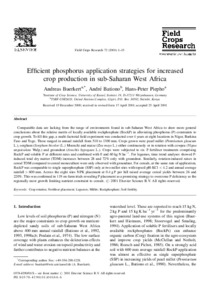Efficient phosphorus application strategies for increased crop production in sub-Saharan West Africa
| dc.date.accessioned | 2007-04-11T09:41:48Z | |
| dc.date.available | 2007-04-11T09:41:48Z | |
| dc.date.issued | 2001 | |
| dc.identifier.issn | 0378-4290 | |
| dc.identifier.uri | urn:nbn:de:hebis:34-2007041117656 | |
| dc.identifier.uri | http://hdl.handle.net/123456789/2007041117656 | |
| dc.format.extent | 377828 bytes | |
| dc.format.mimetype | application/pdf | |
| dc.language.iso | eng | |
| dc.rights | Urheberrechtlich geschützt | |
| dc.rights.uri | https://rightsstatements.org/page/InC/1.0/ | |
| dc.subject | Crop rotation | eng |
| dc.subject | Fertiliser placement | eng |
| dc.subject | Legumes | eng |
| dc.subject | Millet | eng |
| dc.subject | Rockphosphate | eng |
| dc.subject | Soil fertility | eng |
| dc.subject.ddc | 630 | |
| dc.title | Efficient phosphorus application strategies for increased crop production in sub-Saharan West Africa | eng |
| dc.type | Aufsatz | |
| dcterms.abstract | Comparable data are lacking from the range of environments found in sub-Saharan West Africa to draw more general conclusions about the relative merits of locally available rockphosphate (RockP) in alleviating phosphorus (P) constraints to crop growth. To fill this gap, a multi-factorial field experiment was conducted over 4 years at eight locations in Niger, Burkina Faso and Togo. These ranged in annual rainfall from 510 to 1300 mm. Crops grown were pearl millet (Pennisetum glaucum L.), sorghum (Sorghum bicolor (L.) Moench) and maize (Zea mays L.) either continuously or in rotation with cowpea (Vigna unguiculata Walp.) and groundnut (Arachis hypogaea L.). Crops were subjected to six P fertiliser treatments comprising RockP and soluble P at different rates and combined with 0 and 60 kg N ha^-1. For legumes, time trend analyses showed P-induced total dry matter (TDM) increases between 28 and 72% only with groundnut. Similarly, rotation-induced raises in cereal TDM compared to cereal monoculture were only observed with groundnut. For cereals, at the same rate of application, RockP was comparable to single superphosphate (SSP) only at two millet sites with topsoil pH-KCl <4.2 and annual average rainfall >600 mm. Across the eight sites NPK placement at 0.4 g P per hill raised average cereal yields between 26 and 220%. This was confirmed in 119 on-farm trials revealing P placement as a promising strategy to overcome P deficiency as the regionally most growth limiting nutrient constraint to cereals. | eng |
| dcterms.accessRights | open access | |
| dcterms.bibliographicCitation | In: Field Crops Research. Amsterdam : Elsevier. 72.2001, S. 1-15 | |
| dcterms.creator | Bürkert, Andreas | |
| dcterms.creator | Bationo, André | |
| dcterms.creator | Piepho, Hans-Peter | |
| dc.description.everything | The original publication is available at www.elsevier.com | eng |
| dc.subject.swd | Westafrika | ger |
| dc.subject.swd | Getreide | ger |
| dc.subject.swd | Ertragssteigerung | ger |
| dc.subject.swd | Phosphatdüngung | ger |
Dateien zu dieser Ressource
Das Dokument erscheint in:
-
Publikationen [36]

